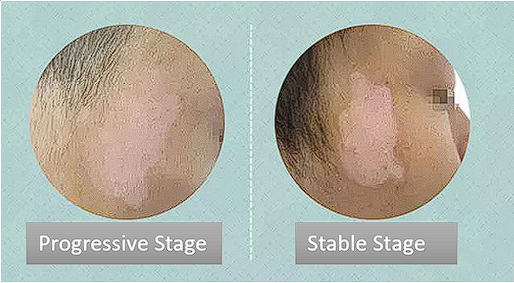The Differences Between Progressive stage Vitiligo and Stable Stage Vitiligo.

According to the development of the white patches, the clinical stage of vitiligo can be divided into progressive stage and stable stage. So how to distinguish between these two stages of the disease and then target the treatment?
First of all, examine whether vitiligo has expanded or not. It is in stable stage if the white patches without expansion and there is no new white patches in six months. On the contrary, it is progressive stage if there is expansion or new white patches in six months. The standard of six months as a time of distinction is relative.
Second, examine the physical signs. If the white patches have clear boundaries, or there is pigmentation around it, then it is stable stage. And if the white patches have blurred boundaries, with no obvious boundary with the normal skin, in a spreading shape, then it is the progressive stage. Usually, in the same patient, there are both clear boundaries and blurred boundaries white patches, which means that some of the white patches are in a static state and some are in an expanding state. However, the stable stage and progressive stage to the vitiligo condition as a whole. As long as there is one white patches enlargement or only one new white patches, it also means that the patient’s condition is in the progressive stage of vitiligo. Only those who have no enlargement of all white patches, clear boundaries and no new white patches are in the stable stage.
Third, the vitiligo stable and progressive stage is not absolute, often alternate. A new white patch is often round, oval or round-like, and the boundary of the white patc turns clear after the stable stage. However, due to the stimulation of some environmental factors, the disease is active again and turns into the progressive stage, at this time the white patches are not radiologically enlarged in equal proportion, but the boundaries are blurred on one side of the white spots, the boundaries with the normal skin disappear, and the white spots are enlarged and spread to the normal skin, which are irregularly shaped. The rapid change between stable and progressing stage, would result the map-like appearance.
The symptoms of the progressive stage vitiligo and stable stage vitiligo in different periods of the disease are very different, so people can determine the period of the disease they are suffering from through the different symptoms changes on the skin. If you are not able to identify the stage of disease, you can go to the hospital for clinical diagnosis of the changes in the skin of the body, under the guidance of dermatologists for scientific treatment of vitiligo disease.
The fourth, vitiligo progressive and stable stage should take different treatment measures:
For the vitiligo patients in the stable stage with improvements, in order to prevent its recurrence, even if the white patches disappear the patients also need to take consolidate treatment for a period of time. Because even after the clinical recovery of vitiligo, there is also a weak state of immunity and circulatory function, even the slight changes of external environment or other factors, may affect the effect of treatment.
If it is in the progressive stage, then the skin should be treated cautiously, avoid stimulate rubbing the skin, try to wear wide, comfortable, cotton clothing, act with some caution to avoid skin damage, so as not to have an isomorphic reaction. And be careful with the medication, you can consult your doctor or pharmacist before using the medication to know whether the medication is irritating to vitiligo.



Leave a Comment